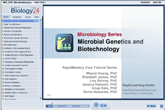| How to Learn in 24 Hours? |
|
| Need Help? |
M-F: 9am-5pm(PST):
Toll-Free: (877) RAPID-10
or 1-877-727-4310
24/7 Online Technical Support:
The Rapid Support Center
vip@rapidlearningcenter.com
Secure Online Order:

|
| Tell-A-Friend: |
Have friends taking science and math courses too? Tell them about our rapid learning system.
|
|
Microbial Genetics and Biotechnology
| Topic Review on "Title": |
DNA Replication
- DNA replication is semi conservative process. DNA is copied from the 5’ to the 3’ direction.
- The process starts at the Origin (of replication)
- Chromosomal proteins are released exposing the DNA.
- DNA helicase unwinds or unzips a local region of DNA breaking hydrogen bonds and exposing the two separate strands.
- This opening is called the replication fork (think of a fork in the road).
- DNA polymerase (an enzyme that matches a complementary base to the one exposed) binds to the open strand.
- Primase synthesizes a short complementary RNA molecule. The RNA primer provides a 3’hydroxyl group for the DNA polymerase to bind.
- The polymerase moves along the strand in the 5’ to 3’ direction.
- Because there are two strands that are antiparellel cells synthesize new strand in two ways.
- One strand is called the leading strand is synthesized continuously as a single long chain of nucleotides.
- Lagging strand is synthesized in short segments that are later joined.
RNA
- Three kinds of RNA that are transcribed from DNA: messenger RNA (mRNA), ribosomal RNA (rRNA) and transfer RNA (rRNA).
- Initiation of transcription RNA polymerase attaches nonspecifically to DNA and slides along until it reaches a promoter site.
- Upon recognition of the promoter RNA polymerase unzips the DNA.
- RNA polymerase links the triphosphate ribonucleotides with their DNA complement. The high energy nucleotides produce the energy for this reaction.
- Transcription terminated when the RNA polymerase falls off the DNA as a result of ether a stop code on the DNA or another enzyme kicking it off.
Mutations
- DNA can be damaged from a variety of mechanisms, including radiation, chemical and mistakes made by the polymerase. This damage can lead to mutation of the DNA. Mutation is a change in the nucleotide base sequence of a genome.
- Mutations are usually deleterious but are sometimes neutral and rarely improvements.
Biotechnology
- Horizontal gene transfer donor cell contributes part of genome to a recipient cell.
- Transduction a virus that has infected one cell, can upon its lysing the host cell take a part of the host genome with it. When the virus then subsequently infects another cell this DNA gets transferred.
- Bacterial conjugation can transfer several traits that are carried on plasmids. These may include the ability to form pili, antibiotic resistance and other metabolic advantageous traits.
- PCR, polymerase chain reaction is a method for copying a specific DNA sequence. A PCR reaction mixture includes: the DNA template, excess amount of DNA primer, polymerase and DNA nucleotides. A thermal cycler mixes, heats and cools the reaction mixture repeatedly allowing for multiple successive DNA replication cycles.
|
| Rapid Study Kit for "Title": |
| Flash Movie |
Flash Game |
Flash Card |
| Core Concept Tutorial |
Problem Solving Drill |
Review Cheat Sheet |
 |
 |
 |
|
| "Title" Tutorial Summary : |
The structure of the prokaryotic and eukaryotic genome and how they replicates is presented. DNA mutations are defined. The cause and effects that mutations have on the genome and organism are presented.
The mechanism of DNA recombination are described and the powerful flexibility that this gives an organism discussed.
Finally biotechnology and recombinant DNA tools, technique and applications will be explored.
|
| Tutorial Features: |
Specific Tutorial Features:
- Prokaryote and Eukaryote genome structure and replication is introduced.
- Nucleic acid structure and the impact it has on DNA replication is reviewed.
- Mutations and mutagens: are outlined: radiation, chemical mutagens, nucleotide analogs, nucleotide altering chemicals and polymerase mistakes.
- Types of DNA and genome mutations: frameshift, insertion, deletions, point mutations.
- DNA repair mechanisms.
- Recombinant technology and its applications.
Series Features:
- Concept map showing inter-connections of new concepts in this tutorial and those previously introduced.
- Definition slides introduce terms as they are needed.
- Visual representation of concepts
- Animated examples—of concepts are used to step wise breakdown a concepts.
- A concise summary is given at the conclusion of the tutorial.
|
| "Title" Topic List: |
Nucleic acid structure and linkages in the DNA molecule.
DNA and chromosome structure in prokaryotes and eukaryotes.
Eukaryote and prokaryote genome structure.
DNA replication and regulation.
The structure of a gene.
Central dogma of transfer of genetic information.
Genotype and phenotype relationships.
Mutations, radiation, chemical and replication-repair errors.
Biotechnology applications of recombinant DNA.
|
See all 24 lessons in Anatomy and Physiology, including concept tutorials, problem drills and cheat sheets:
Teach Yourself Microbiology Visually in 24 Hours
|



